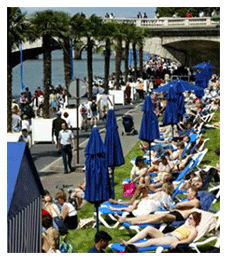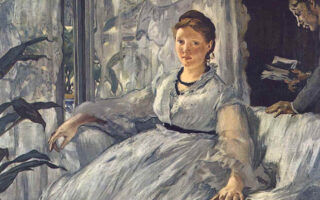Letter from Paris Plage

- SUBSCRIBE
- ALREADY SUBSCRIBED?
BECOME A BONJOUR PARIS MEMBER
Gain full access to our collection of over 5,000 articles and bring the City of Light into your life. Just 60 USD per year.
Find out why you should become a member here.
Sign in
Fill in your credentials below.
To find out more about the river Seine and other spots of summer leisure, look up Around and About Paris,by Thirza Vallois, published by Iliad Books. and Romantic Paris, by Thirza Vallois, published by Arris Books.
To order your copies of Around and About Paris and Romantic Paris:
http://www.thirzavallois.com
 Although many in the Parisian media praise wholeheartedly Mayor Bertrand Delanoë’s initiative to have turned a section of the Right Bank quais of the Seine into a summer beach, and although one of London’s hotels has decided to follow suit and install a "plage" in its main lobby come summer, I personally have my reservations about spending any of my leisure time on any spot of the narrow strip of Paris Plage. I have never found crowded places an attraction, unless the place or the event attached to it is intrinsically tied up with big crowds, like, right now for example, the Olympic Games and their opening ceremony last night, which millions of us watched on TV last night, and would have enjoyed even more in situ, within that human ocean.
Although many in the Parisian media praise wholeheartedly Mayor Bertrand Delanoë’s initiative to have turned a section of the Right Bank quais of the Seine into a summer beach, and although one of London’s hotels has decided to follow suit and install a "plage" in its main lobby come summer, I personally have my reservations about spending any of my leisure time on any spot of the narrow strip of Paris Plage. I have never found crowded places an attraction, unless the place or the event attached to it is intrinsically tied up with big crowds, like, right now for example, the Olympic Games and their opening ceremony last night, which millions of us watched on TV last night, and would have enjoyed even more in situ, within that human ocean.But the banks of the Seine are a different story, diffusing a poetry of romance which requires seclusion. Admittedly, the 3.5km strip taken over by Paris Plage, is even more mishandled the rest of the year, having been turned into a motorway several decades back. Since this is where my personal first love story in Paris and with Paris (the two often mingle) took place in pre-motorway days, I have all the more reason to feel personally resentful towards the car drivers who have pushed my fellow lovers and fishermen and myself away from the Seine.
In that sense, Bertrand Delanoë’s imaginative initiative is poetic justice, and a happy improvement on the polluting congestion that prevails the rest of the year. I have no problem with the boxed palm trees, even though I can’t warm up to this poor man’s version of the one-time glamorous Promenade des Anglais in Nice. And obviously it is nice to have the quais’ tarmac covered with sand, or grass, but isn’t that too kind of paying lip service to those who can’t afford to go away or impress the community of August tourists who are willing to gobble anything. Give me the sandy beaches of Britanny any day rather than squeeze myself into a little sandy corner of polluted Paris.
Yes, the French are stylish, and the parasols look neat and it’s wonderful that everyone can go to the food stands and buy themselves snacks as they do on the beaches of the south of France at a much higher cost, but I prefer going to my regular icecream stand, on the right hand side of the main entrance to the Luxembourg Gardens (on Boulevard St-Michel, by the round flowery fountain of Place Edmond Rostand), whose choice of ice-cream and sorbet is mindboggling, and at least on a par with Berthillon’s, and whose strawberry and mint or bush peach flavours, for instance, are to die for. Yes, I do think it’s great that a swimming pool has been added this year to Paris Plage, and that everyone should be able to dip into cool water on a hot day. It’s a wonderful initiative and certainly less cruel on the children than making them bake in the sun while queueing up in front of the Louvre glass pyramid, for hours on end, because their well-meaning parents feel obliged to forcefeed them with culture during their sketchy visit to the City of Light and Enlightenment.
But wouldn’t you, or the children, rather enjoy a swimming pool that has more flexible opening hours? Admittedly, this one charges no admission fees, which is an attraction, especially for families of small means. Admittedly too, children are less bothered about lack of space, as is the case in Paris Plage. They are not out there for a fitness session and don’t mind jostling one another in the water. Yet, whilst watching the scene, my mind started wandering several summers back, when I happened to be strolling by the fountains of Parc André Citroën with the BBC, while shooting a travel show on Paris. It was a very warm morning and we walked towards the set of fountains, where we were gratified by a delightful scene-crowds of children skipping merrily in the fountains like young colts, some had even bothered to come dressed in swimming suits, under the approving, affectionate watch of their mothers or some other adult guardians.
In front of the fountains was displayed a big notice which read: "IL EST INTERDIT DE JOUER DANS LES JEUX D’EAU", or words to that effect, but which, naturally, nobody paid any heed to, neither the children nor the adults, which was fine, because no harm was being done and the notice had no raison d’être other than providing French bureaucracy with the pleasure of setting up another rule. In other words, the notice was deemed stupid and not even worthy of one’s attention. Like all French regulations, it was tacitly agreed, it was set up in order to be broken. Even more so, the French citizen sees it as his duty to break all regulations that get in his way. For those who remember the 1968 student events, two slogans were attached to them:
a) "Il est interdit d’interdire."
b)"L’imagination au pouvoir."
In a truly French spirit, the children at Parc Citroën on that warm morning, who for better and for worse had inherited the legacy of the 1968 generation, fulfilled both messages spontaneously:
a)They broke the rules wholeheartedly.
b) They used their imagination and turned the fountains—spontaneously, that’s the beauty of it—into swimming pools, and had the extra advantage of not having to queue up, nor stick to a limited time slot. Besides, they too paid no admission fees whatsoever, which means they gained on all fronts.
Here are a few suggestions, for the remaining summer days, all of which are described extensively in Around and About Paris and/or Romantic Paris and are situated quite a way off the beaten tourist highway:
* Square René Galle, in the 13th arr. at all times of day in midsummer, to be combined with a fabulous Basque meal at Etchegorry (check if open on August: 01 44 08 83 51).
* Parc Montsouris in the 14th arr.
* The Ile aux Cygnes, in the 15th arr. especially early in the morning,
* Square des Batignolles in the 17th arr. to be combined with a walk through the birthplace of the Impressionist School of painting.
* Buttes Chaumont in the 19th arr. to be combined with a south-western meal in the park, at Le Pavillon Puebla (closed through three weeks in August: 01 42 08 92 62)
Thirza Vallois is the author of Around and About Paris, Volume I, II, III published by Iliad Books, UK. Romantic Paris, co-published by Interlink Publishing Group, US and Arris Books, UK. Available at http://www.thirzavallois.com. Her forthcoming book on the Aveyron is due to be published next year.


